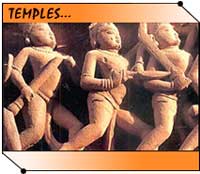|
|
Architectural Heritage of India |
 |
|
Indian Architecture - An Introduction |
In broad terms, Indian architecture might show a yearn for continuity and static, but if you look closely at the 4000 years history of Indian architecture, changes and dynamism will come out loudly and clearly. Starting from the urban architecture of the Harappan civilization to the contemporary architecture of India, change has always been vital. Indian architecture of the old has taken influences liberally from the regular inflow of cultures coming to India. In turn, India also played a major role in influencing and shaping the architecture of South East Asian countries.
Travel to India and experience the architectural heritage scattered through the length and breath of this country. The architectural wonders of India include more than 20 World Heritage Sites and hundreds more about, which not many know. Our tour packages for the architectural heritage sites of India will make you understand the known and unknown facets of Indian architecture.
More Information and Travel Related Services
|
|
Temple Architecture |
The Temple Architecture follows the concept of four compartments, namely an entrance porch (the ardhamandap), the vestibule (antarala) and the sanctum (garbhagriha). In some of the large temples an extra mandap with lateral transepts is added for size and splendor, converting it into a large assembly hall.

The Khajuraho temple Located in the forested plains of Madhya Pradesh, in the region known as Bundelkhand is a well-known example of the temple architecture and exquisite sculpture.
Dravidian style of temple architecture is more visible in the numerous temples of Tamil Nadu and Andhra Pradesh. These temples built during the times of enduring peace (southern India had enough of that) are huge in size and some times encompasses entire townships. These temples at the height of their glory were center of all activities of social life and were parallel centers of economic and political powers. Good examples of Dravidian style are temples of Tanjore, Madurai, Mahabalipuram, temples of Badami and Pattadakal, and temples of Kanchipuram.
More Information and Travel Related Services
|
|
Indo- Islamic Architecture |
Before the Islamic elements of architecture were introduced to India, they had already passed through different experimental phases in other countries like Egypt, Iran and Iraq. The Indo-Islamic monuments were typical mortar-masonry works formed of dressed stones unlike most Islamic monuments of these countries, which were largely constructed in brick, plaster and rubble.
Islamic architecture in India can be classified into three sections namely Delhi or the Imperial style (1191 to 1557AD); the Provincial style, encompassing the surrounding areas like Jaunpur and the Deccan, and the Mughal style (1526 to 1707AD).
The Indo-Islamic architecture was eased by the knowledge and skill possessed by the Indian craftsmen, who had mastered the art of stonework for centuries and used their experience while constructing Islamic monuments in India.
In simple terms the Islamic architecture in India can be divided into religious and secular. Mosques and Tombs represent the religious architecture, while palaces and forts are examples of secular Islamic architecture.
More Information and Travel Related Services
|
|
Indo -European Architecture |
When the British left India, besides the legacy of language, social customs, the modes of administrative functioning, and more enduringly, their buildings scattered across twenty-four latitudes and widely varied terrain.
A lot of the construction in British India was the work of amateurs and military engineers. Their work reflects a curious adaptation of local materials and weather to a longing for home being expressed in the implantation of European styles in a tropical land. In all of India, apart from Shimla perhaps, it is the city of Bombay, which shows the greatest incorporation of a multitude of divergent styles popular in the Victoria era. The various examples of the indo- European architecture being the Victoria Memorial, From the Fort the Fort area down to the cantonment at Colaba still stand buildings with examples of diverse architectural features such as German gables, Dutch roofs, Swiss timbering, Romance arches and Tudor casements mingled with more ethnic oriental embellishments.
While Aldous Huxley is said to have sneered and dismissed Bombay s pretentious, architectural historian, Gavin Stamp has called it the best Victorian Gothic city in the world.
Perhaps the most fitting monuments both in name and splendor, the very symbol of the British in Victorian Bombay is a building that was opened in 1887 in time to celebrate Queen Victoria Terminus or VT. Today it is better known as Chhatrapati Shivaji Terminus.
More Information and Travel Related Services
|
|
Monuments of India |
Monuments are the backdrop of the world's largest democracy and a slice of India's history in which numerous civilizations flourished.

The exquisite architecture and the intricate embellishments of the Indian monuments represent one of the most prominent facets of the multi-faceted India. An architectural feat in itself, each monument is a strikingly splendid specimen of incredible artistry, shrouding a sense of mystery, intrigue and romance. Be it the marvel in white marble, the unparalleled Taj Mahal, one of the seven wonders of the world; or the red stone splendor, the imposing Red Fort; or the magnificence of temple art of Khajuraho, Konark and Hampi, therein is evident the master craftsmanship and elegance, that brings to the fore the grandeur of the bygone era.
More Information and Travel Related Services
|  |
|
|









